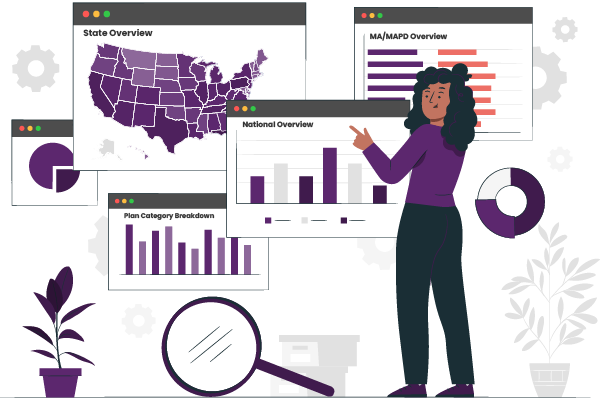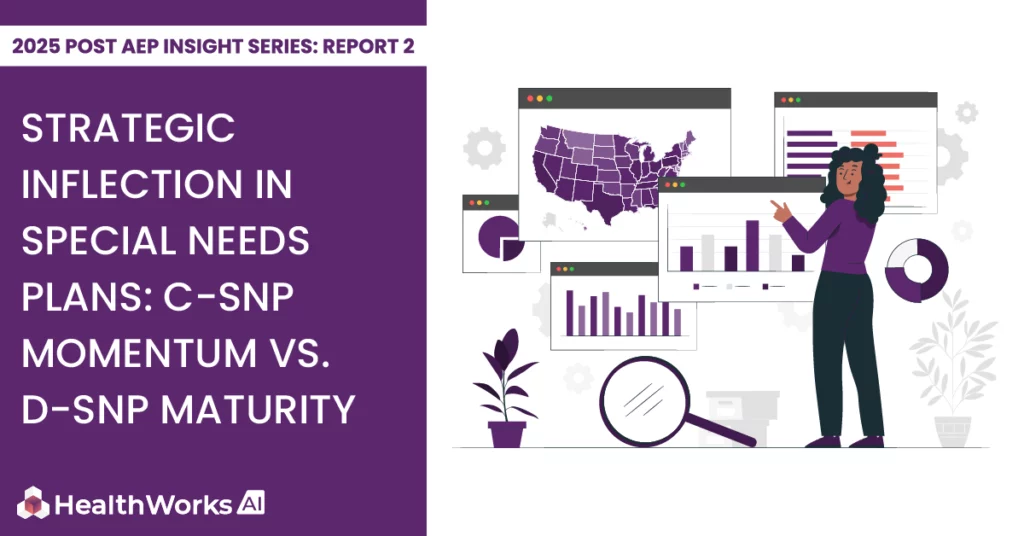2025 Post AEP Insight Series: Report 3 📊
Shifting Priorities: The Evolution of Supplemental, Enhanced, and SSBCI Benefits in MA Plans
2025 Medicare Advantage SNP trends: C-SNPs surge with 21.4% plan growth, D-SNPs stabilize. Insights on enrollment, premiums, and payor strategies for 2026 bids.
May 05, 2025 Market Research

Table of Contents
Introduction
As Medicare Advantage (MA) continues to advance, Benefits have emerged as a key factor in distinguishing plans and attracting consumers. In addition to the foundational services covered by Original Medicare, MA plans increasingly offer a wide range of Supplemental, Enhanced, and Special Supplemental Benefits for the Chronically Ill (SSBCI) to enhance health outcomes and address social determinants of health.
This analysis provides a detailed examination of the varied spectrum of MA benefits, with particular attention to Chronic Condition Special Needs Plans (C-SNPs) and Dual Eligible Special Needs Plans (D-SNPs). Utilizing the CMS Landscape, Crosswalk, and Plan Benefit Package (PBP) data, we explore how benefit offerings have transformed, where expansions or reductions are taking place, and the strategic direction plans are pursuing in response to regulatory flexibility and competitive dynamics.
Supplemental Benefits
Key Trends:
- Selective Retraction of Supplemental Benefits: While benefit offerings have expanded, 2024–2025 saw notable pullbacks in non-core areas like OTC, Meals, Transportation, Acupuncture, and Chiropractic, indicating shifting plan priorities and cost-balancing.
- Core Benefits Remain Widely Available: Despite some cuts, essential services like Eye Exams, Eyewear, Preventive Dental, Audiology tests, and Enhanced Benefits continue to be offered in 96 %+ of Medicare Advantage and SNP plans.
- Core Clinical Benefits Drive Enrollment Growth: Plans offering essential healthcare services—Outpatient Blood, Inpatient Hospital, Routine Physicals, Vision, and Dental Preventive—saw enrollment growth of over 1 million each, showing strong member preference alignment.
- C-SNPs Show Aggressive Growth and Benefit Saturation: C-SNP enrollment grew by over 70% YoY, with nearly all members gaining access to vision, hearing, emergency, and blood-related benefits. Chiropractic and Acupuncture benefits remain stagnant or declining.
- D-SNPs Show High Coverage but Slowed Benefit Growth: D-SNPs continue to offer broad Supplemental benefits (e.g., Enhanced, Eye Wear, Dental Comprehensive), but growth has slowed considerably. OTC growth dropped from 35% to 5.4%, signaling a plateau.
- Chiropractic and Acupuncture See Sharp Declines: These benefits faced the steepest drop-offs—Chiropractic lost ~870K enrollees, reflecting diminished prioritization among plans and possibly low member demand or budget reallocation.
Over the years, we have noticed a general trend of expanding benefit offerings in Medicare Advantage plans. Yet, in 2024, there was a marked reduction in some less crucial benefits, likely due to shifting priorities among beneficiaries. By 2025, a more widespread decrease across various benefit categories occurred, notably Over-the-Counter(OTC) benefits, which decreased from 5,051 to 4,424 plans. Despite some reductions in 2025, benefits such as Eye Exams (5,591), Eye Wear (5,497), Enhanced Benefits (5,493), Audiology tests (5,488), and Dental Preventive (5,462) remained present in over 96% of plans. Conversely, Meal and Transportation benefits declined to 381 and 327 plans offering these benefits, respectively.
Enrollment trends in Medicare Advantage plans highlight a growing preference among beneficiaries for essential healthcare services. Plans offering benefits like Worldwide Emergency/Urgent Coverage, Inpatient Hospital-Acute Services, Outpatient Blood, and Routine Physical Exams each gained approximately 1.2 million enrollees. Vision and hearing-related benefits also gained significant traction, with Eye Exams and Preventive Dental services attracting about 1.1 million new members each. At the same time, Eye Wear and Audiology tests drew approximately 1 million additional beneficiaries. Overall, the enrollment in plans with Supplemental benefit offerings grew at an average rate of 4.58% yearly. In contrast, plans featuring benefits such as Dental Comprehensive, OTC, Acupuncture, Chiropractic, and Transportation experienced significant decreases, with enrollment losses ranging from 260K to 1.6 million.
C-SNP:
By the year 2025, over 96% of C-SNP plans incorporate vital additional benefits, including Eye Exam (389 plans), Eyewear (387), Preventive Dental Services (381), Audiology tests (379), Enhanced Coverage (379), and Hearing Devices (376), illustrating a broad adoption within the sector. Benefits related to Outpatient Blood saw the most substantial increase, rising from 284 to 363 plans. Conversely, there was no rise in the offerings for Chiropractic and Acupuncture services this year.
More than 98% of C-SNP participants have access to Eye Exam, Audiology tests, Global Emergency/Urgent Coverage, Outpatient Blood, Hearing Devices, Eyewear, and Preventive Dental Care, with enrollment figures between 1.08 and 1.09 million individuals for each benefit. Overall, C-SNP membership has experienced a striking 70.08% Year-over-Year (YoY)increase, with extensive benefit coverage becoming commonplace. Except for Chiropractic services, which experienced a minor 2.82% decrease, affecting 186K participants.
D-SNP:
D-SNP plans maintain a strong focus on offering extensive Supplemental benefits, with Enhanced Benefits prominently featured in 97% (919) of the plans. Eye Wear is also prevalent, present in 917 of plans, closely followed by Eye Exams at 94% (895), and Dental Comprehensive coverage at 93% (885), demonstrating a robust alignment with the needs of members. While many Supplemental benefits have expanded, some have faced reductions, notably Meal, Acupuncture and Chiropractic benefits, which have decreased by 7, 8, and 52 plans, respectively. Importantly, none of the D-SNPs provide Skilled Nursing Facility (SNF), Cardiac, or Outpatient Drug coverage.
Significantly, 97.7% of D-SNP members still have access to OTC and Enhanced Benefits; however, the expansion rate of these offerings has slowed. The year-over-year growth rate for the OTC benefit fell dramatically from 35.09% in 2024 to a mere 5.42% in 2025, despite an increase of 302K enrollees. Similarly, Enhanced Benefits experienced a deceleration in growth from 17.94% to 2.78%, resulting in an additional 158K enrollees. Eyewear benefits followed this trend, reducing growth from 18.81% to 2.87%, even as 161K new enrollees were added. Meanwhile, some benefits saw a decline in enrollment, particularly Transport, Meal, Podiatry, Chiropractic, and Acupuncture services. Chiropractic experienced the most significant reduction, losing about 870K enrollees.
Enhanced Benefits
Key Trends:
- Widespread contraction across most enhanced benefits: Most of the 22 Enhanced Benefits saw a decline in plan availability. Notably, Remote Access Technology (−1,229 plans) and PERS (−722 plans) experienced steep cuts, leading to significant enrollment losses of 6.28 million and 5.01 million, respectively.
- Fitness remains the dominant enhanced benefit despite a slight pullback: Although available in 91.32% of all MA plans (down 257 plans), Fitness still saw a 3.01% increase in enrollment, reaching 26.86 million members, maintaining its status as the most subscribed enhanced benefit.
- Bathroom Safety Devices and Alternative Therapies see significant growth: These two benefits were among the few to expand in both plan count and enrollment. Bathroom Safety Devices rose 6.94% in plan inclusion, attracting 11.63 million members (+19.67%), while Alternative Therapies grew by 382 plans, adding 1.05 million enrollees (+75.41%).
- C-SNPs shift toward practical, at-home support benefits: Fitness (94% of plans) and Bathroom Safety Devices (54%) emerged as top drivers of enrollment gains in C-SNPs, adding 409,000 and 397,000 members, respectively. Meanwhile, benefits like Remote Tech, PERS, and In-Home Support Services declined in both offering and enrollment.
- Emerging and previously absent benefits make a small debut: For the first time, C-SNPs introduced benefits such as Wigs for Hair Loss due to Chemotherapy and Adult Day Health Services, appearing in only a few plans but reflecting a trend toward niche, high-touch offerings.
- D-SNPs show selective expansion, especially for safety and wellness: D-SNPs significantly expanded benefits like Bathroom Safety Devices (+267 plans, +1.22 million enrollees), Alternative Therapies (+114 plans), and Health Education. Meanwhile, PERS, Remote Access Technology, and Home-Based Palliative Care saw significant reductions, highlighting a shift in what plans prioritize for this population.
Among the 22 Enhanced Benefits, the majority have experienced a reduction in the number of plans offering them. Fitness benefits continue to be the most commonly available enhanced benefit, present in 91.32% of plans in 2025, despite a decrease of 257 plans from the prior year. Nevertheless, enrollment in these plans has increased by 3.01% YoY, reaching 26.86 million enrollees. The most significant decline was seen in Remote Access Technology plans, where 1,229 plans were affected, leading to a substantial enrollment drop of 6.28 million enrollees for the first time in 2025. Plans offering Personal Emergency Response Systems (PERS) decreased by 722, resulting in a 5.01 million reduction in enrollment. Medical Nutrition Therapy plans also faced a decline of 433, causing a loss of 1.66 million enrollees.
Conversely, some benefits have seen growth in both their plan availability and enrollment numbers. Bathroom Safety Devices experienced a 6.94% increase in plan inclusion, with enrollment rising to 11.63 million, reflecting a 19.67% YoY growth. Similarly, Alternative Therapies underwent a notable expansion, with 382 additional plans offering this benefit, leading to a 75.41% YoY increase in enrollment, which grew by 1.05 million enrollees.
C-SNP:
In the landscape of C-SNP plans for 2025, Fitness (94%) and Bathroom Safety Devices (54%) emerged as the leading enhanced benefits, significantly driving enrollment increases of +409K and +397K, respectively. Conversely, offerings such as Remote Access Technology, PERS, and In-Home Support Services saw reductions in both availability and enrollments. These benefits decreased by 15, 19, and 9 plans, with enrollment figures dropping to 448K (−33.8K), 257K (−120.9K), and 149K (−48.9K), respectively.
For the first time, 2025 saw an uptick in enrollments for plans that include Post-Discharge In-Home Medication Reconciliation and Telemonitoring Services, gaining +5K and +4K enrollees, respectively. Re-Admission Prevention, exhibiting its usual variability over recent years, recovered in 2025 with an increase of +5K enrollees. Moreover, Wigs for Hair Loss Related to Chemotherapy and Adult Day Health Services, which were absent from all C-SNP plans in 2024, were introduced in 2025. These benefits appeared in two and one plans, enrolling +281 and +69 members, respectively.
D-SNP:
In 2025, D-SNPs are continuously advancing their enhanced benefit offerings, with several essential services undergoing notable expansions. The most significant increase was observed in Bathroom Safety Devices, which were incorporated into 267 additional plans and are now featured in 58% of D-SNPs, resulting in a substantial rise in enrollment by 1.22 million members, reaching a total of 4.10 million. Alternative Therapies extended to 114 more plans (covering 18%), attracting 387K new enrollees (791K in total), while Health Education expanded by 38 plans and is now included in 37% of plans, with a 90K increase in enrollment (totaling 1.49 million). Fitness benefits, already prevalent, were added to 32 more plans, now available in 90% of D-SNPs. Although there was a decrease of 96K members, Fitness remains the most subscribed benefit with 5.51 million participants.
On the other hand, several benefits experienced significant reductions. Plans providing PERS, Remote Access Technology, and In-Home Support Services decreased by 245, 141, and 93 plans, respectively. These cutbacks resulted in enrollment reductions of 2.49 million (down to 1.28 million), 1.75 million (now 2.90 million), and 623K (to 650K), indicating a strategic move away from these offerings. Furthermore, Home-Based Palliative Care witnessed a dramatic 87.21% drop in enrollment YoY , and Medical Nutrition Therapy, after experiencing an 89.04% increase in 2024, sharply declined by 79.54% in 2025.
SSBCI
Key Trends:
- Food Produce and General Supports dominate VBID offerings: Food Produce (32%) and General Supports for Living (24%) remain the most prevalent VBID benefits, with enrollments reaching 9.30 million and 7.63 million, respectively. Both benefits grew strongly, adding over 3 million new enrollees each in 2025.
- Emerging non-clinical benefits gain traction: Non-Medical Transportation, Indoor Air Quality, and Pest Control continued to expand in both availability and enrollment. Notably, Non-Medical Transportation grew by 308 plans and 951,000 enrollees, highlighting increasing attention to social determinants of health.
- Complementary Therapy and Self-Direction services are in decline: Complementary Therapy dropped to just 82 plans and lost 42% of its enrollment year-over-year. Services Supporting Self-Direction also declined by 88 plans, with a loss of 579,000 enrollees, continuing a multi-year trend of decreased adoption.
- C-SNP plans deepen their focus on food and environmental support: Food Produce is now included in 82% of all C-SNP plans and saw a 95% year-over-year increase in enrollment. Newer benefits like Pest Control, Indoor Air Quality, and Non-Medical Transportation are also gaining ground in C-SNPs, each drawing tens of thousands of new enrollees.
- Some benefits show signs of early saturation: Even benefits still growing, like Social Needs Quality, are seeing slowing momentum. Its enrollment growth fell from 124% in 2024 to 33.7% in 2025, suggesting that some categories may be reaching their natural ceiling.
- D-SNPs continue prioritizing social and home-based supports: SSBCI benefits expanded meaningfully in D-SNPs, led by Food Produce (5.49 million enrollees), General Supports (5.13 million), and Home Modifications, which jumped from 52K to 374K members. At the same time, Meal Beyond, Complementary Therapy, and Self-Direction services saw enrollment losses of up to 451,000, reflecting a reallocation toward higher-impact social supports.
In 2025, Food Produce (32%) and General Supports for Living (24%) continue to be the most common VBID benefits, available in 1,831 and 1,391 plans, respectively. Food Produce experienced a notable increase of 3.51 million enrollees, reaching a total of 9.30 million. General Supports for Living closely followed, with an additional 3.23 million enrollees, totaling 7.63 million.
Non-Medical Transportation also saw significant growth, with 308 more plans now including this benefit (for a total of 930), leading to an enrollment increase of 951K. Benefits like Indoor Air Quality and Pest Control also became more widely available, offered in 365 and 461 plans, respectively, with enrollments rising to 2.13 million and 2.54 million.
Conversely, some VBID benefits experienced declines. Complementary Therapy decreased to just 82 plans (a reduction of 77), with a sharp 42.27% YoY drop in enrollment. Services Supporting Self-Direction fell by 88 plans, down to 93, losing 579K enrollees. Meal Beyond declined, with 21 fewer plans and 345K fewer enrollees.
C-SNP:
In 2025, an extra 117 plans incorporated the Food Produce advantage, elevating its inclusion to 82% of all C-SNP plans and contributing to a significant 94.97% YoY expansion in enrollment. The General Supports for Living benefit also grew, with 188 plans now serving 400,000 enrollees. At the same time, new benefits such as Non-Medical Transportation, Pest Control, and Indoor Air Quality showed notable progress, attracting tens of thousands of enrollees and considerably broadening their plan reach. Specifically, Non-Medical Transportation welcomed 93,000 new members and is currently provided by 143 plans, representing 24.9% of C-SNPs.
Conversely, Complementary Therapy and Services Supporting Self-Direction, which have been gradually decreasing in availability over the past years, faced enrollment decreases for the first time in 2025, declining by 19K and 13K enrollees, respectively. Meal Beyond persisted in its downward trajectory, and Home Modifications vanished entirely from the 2025 C-SNP VBID framework. Even among benefits that are still expanding, some signs of reaching capacity are evident, with Social Needs Quality gaining 54K enrollees. Still, its growth slowed from 124% in 2024 to 33.74% in 2025, indicating early signs of market saturation in certain areas.
D-SNP:
In 2025, the benefits of SSBCI in D-SNPs saw substantial growth, with plans increasingly prioritizing social determinants of health. Food Produce became the most commonly included benefit, featured in 833 plans and serving over 5.49 million members. Likewise, General Supports for Living expanded to 741 plans, reaching over 5.13 million participants, marking an increase of +3.02 million. Other rapidly expanding benefits included Non-Medical Transportation, which added 217 plans and reached 2.33 million enrollees, Indoor Air Quality, which grew by 142 plans, and Home Modifications, which surged to 94 plans with enrollment rising from 52K in 2024 to 374K in 2025, indicating a renewed focus on home-based care supports.
Conversely, Meal Beyond, Services Supporting Self-Direction, and Complementary Therapy saw significant enrollment decreases, with reductions of 100K, 451K, and 389K, respectively, bringing the total enrollments for these benefits down to 633K, 247K, and 241K.
Conclusion
In essence, our examination reveals a dynamic evolution in Medicare Advantage benefit configurations, influenced by regulatory shifts, market competition, and changing member demands. Core Supplemental offerings remain prevalent, yet 2025 marks a cautious pullback in non-essential areas like over-the-counter items, meal services, and transportation. Enhanced benefits and SSBCI present a more complex picture, such as bathroom safety equipment and alternative medical treatments, are gaining momentum. In contrast, others, like Personal Emergency Response Systems (PERS) and Remote Access Technology, are experiencing significant reductions.
C-SNPs and D-SNPs persist in leading comprehensive benefits, expanding in critical segments such as vision, hearing, and SSBCI provisions. Nonetheless, signs of market saturation and strategic realignments are surfacing, particularly in benefits with lower utilization or higher costs. These developments illustrate how plans align member requirements with operational effectiveness, indicating a more focused and adaptive strategy for benefit design as we approach the 2026 bidding period.


